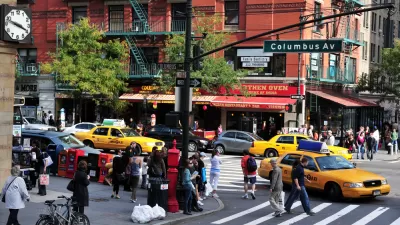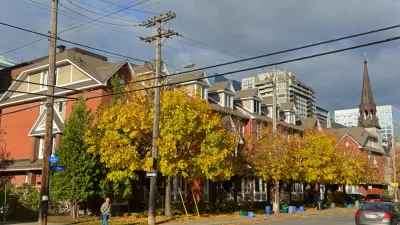In the fifty years since Jane Jacobs introduced the "eyes on the street" theory, it's become a commonly accepted conceit that a mix of use reduces crime. A new study calls that theory into question.
"Jane Jacobs 'had it backwards,' according to a report in this month’s University of Pennsylvania Law Review."
Matt Bevilacqua discusses the findings reported by researchers from RAND, the University of Pennsylvania, and the University of Southern California.
"Focusing on more than 200 blocks in eight high-crime Los Angeles neighborhoods, the report found that areas zoned for mixed-use development had lower crime rates than those zoned for commercial uses only. Areas purely made up of residences, however, had lower crime rates than either."
“[W]e find that residential zoning is associated with substantially lower crime than commercial zoning or mixed-use zoning,” the researchers write, later adding, “With respect to natural surveillance, we find no support for Jacobs’s argument that commercial uses will reduce crime by encouraging a robust street life and ‘eyes on the street.’”
"The report also notes that assaults, robberies, thefts and burglaries decreased when residential housing was introduced into single-use commercial zones," adds Bevilacqua. "These crimes increased, however, when businesses were introduced into residiential-only [sic] areas, backing up the notion, for one, that a 'place of business in a residence neighborhood furnishes an excuse for any criminal to go into the neighborhood.'”
"The authors do stress the need for further research on the built environment before drawing any definitive conclusions about its effect on crime rates," he concludes. "So it will take more evidence before we can heed the suggestion that new urbanists have been mixing it up all these years."
FULL STORY: Researchers Challenge Jane Jacobsian Notion that “Eyes On the Street” Reduce Crime

Trump Administration Could Effectively End Housing Voucher Program
Federal officials are eyeing major cuts to the Section 8 program that helps millions of low-income households pay rent.

Planetizen Federal Action Tracker
A weekly monitor of how Trump’s orders and actions are impacting planners and planning in America.

The 120 Year Old Tiny Home Villages That Sheltered San Francisco’s Earthquake Refugees
More than a century ago, San Francisco mobilized to house thousands of residents displaced by the 1906 earthquake. Could their strategy offer a model for the present?

HSR Reaches Key Settlement in Northern California City
The state’s high-speed rail authority reached an agreement with Millbrae, a key city on the train’s proposed route to San Francisco.

Washington State Legislature Passes Parking Reform Bill
A bill that would limit parking requirements for new developments is headed to the governor’s desk.

Missouri Law Would Ban Protections for Housing Voucher Users
A state law seeks to overturn source-of-income discrimination bans passed by several Missouri cities.
Urban Design for Planners 1: Software Tools
This six-course series explores essential urban design concepts using open source software and equips planners with the tools they need to participate fully in the urban design process.
Planning for Universal Design
Learn the tools for implementing Universal Design in planning regulations.
Ada County Highway District
Clanton & Associates, Inc.
Jessamine County Fiscal Court
Institute for Housing and Urban Development Studies (IHS)
City of Grandview
Harvard GSD Executive Education
Toledo-Lucas County Plan Commissions
Salt Lake City
NYU Wagner Graduate School of Public Service





























